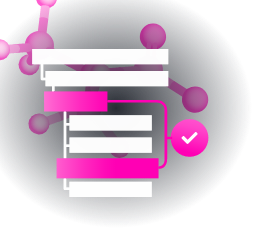Identification
- Generic Name
- Canertinib
- DrugBank Accession Number
- DB05424
- Background
-
Canertinib is a pan-erbB tyrosine kinase inhibitor which work against esophageal squamous cell carcinoma in vitro and in vivo. Canertinib treatment significantly affects tumour metabolism, proliferation and hypoxia as determined by PET.
- Type
- Small Molecule
- Groups
- Investigational
- Structure
- Weight
-
Average: 485.938
Monoisotopic: 485.162995603 - Chemical Formula
- C24H25ClFN5O3
- Synonyms
-
- Canertinib
- External IDs
-
- PD-183805
Pharmacology
- Indication
-
Investigated for use/treatment in breast cancer and lung cancer.
 Reduce drug development failure ratesBuild, train, & validate machine-learning models
Reduce drug development failure ratesBuild, train, & validate machine-learning models
with evidence-based and structured datasets.Build, train, & validate predictive machine-learning models with structured datasets. - Contraindications & Blackbox Warnings
-
 Avoid life-threatening adverse drug eventsImprove clinical decision support with information oncontraindications & blackbox warnings, population restrictions, harmful risks, & more.Avoid life-threatening adverse drug events & improve clinical decision support.
Avoid life-threatening adverse drug eventsImprove clinical decision support with information oncontraindications & blackbox warnings, population restrictions, harmful risks, & more.Avoid life-threatening adverse drug events & improve clinical decision support. - Pharmacodynamics
-
Not Available
- Mechanism of action
-
CI-1033 effectively inhibits the growth of esophageal squamous cell carcinoma which co-expresses both EGFR and HER2 with the inhibition of phosphorylation of both MAPK and AKT. Some studies suggest that CI-1033 holds significant clinical potential in esophageal cancer.
Target Actions Organism U表皮生长前沿空中管制官tor receptor Not Available Humans - Absorption
-
Not Available
- Volume of distribution
-
Not Available
- Protein binding
-
Not Available
- Metabolism
- Not Available
- Route of elimination
-
Not Available
- Half-life
-
Not Available
- Clearance
-
Not Available
- Adverse Effects
-
 Improve decision support & research outcomesWith structured adverse effects data, including:blackbox warnings, adverse reactions, warning & precautions, & incidence rates.Improve decision support & research outcomes with our structured adverse effects data.
Improve decision support & research outcomesWith structured adverse effects data, including:blackbox warnings, adverse reactions, warning & precautions, & incidence rates.Improve decision support & research outcomes with our structured adverse effects data. - Toxicity
-
Not Available
- Pathways
- Not Available
- Pharmacogenomic Effects/ADRsBrowse all" title="" id="snp-actions-info" class="drug-info-popup" href="javascript:void(0);">
- Not Available
Interactions
- Drug InteractionsLearn More" title="" id="structured-interactions-info" class="drug-info-popup" href="javascript:void(0);">
-
This information should not be interpreted without the help of a healthcare provider. If you believe you are experiencing an interaction, contact a healthcare provider immediately. The absence of an interaction does not necessarily mean no interactions exist.
Drug Interaction Integrate drug-drug
interactions in your softwareAbaloparatide The therapeutic efficacy of Abaloparatide can be decreased when used in combination with Canertinib. Acetaminophen The serum concentration of Acetaminophen can be increased when it is combined with Canertinib. Articaine The risk or severity of methemoglobinemia can be increased when Canertinib is combined with Articaine. Benzocaine The risk or severity of methemoglobinemia can be increased when Canertinib is combined with Benzocaine. Benzyl alcohol The risk or severity of methemoglobinemia can be increased when Canertinib is combined with Benzyl alcohol. Bupivacaine The risk or severity of methemoglobinemia can be increased when Canertinib is combined with Bupivacaine. Butacaine The risk or severity of methemoglobinemia can be increased when Canertinib is combined with Butacaine. Butamben The risk or severity of methemoglobinemia can be increased when Canertinib is combined with Butamben. Capsaicin The risk or severity of methemoglobinemia can be increased when Canertinib is combined with Capsaicin. Carbimazole The therapeutic efficacy of Carbimazole can be decreased when used in combination with Canertinib.  Identify potential medication risksEasily compare up to 40 drugs with our drug interaction checker.Get severity rating, description, and management advice.Learn more
Identify potential medication risksEasily compare up to 40 drugs with our drug interaction checker.Get severity rating, description, and management advice.Learn more - Food Interactions
- Not Available
Products
-
 Drug product information from 10+ global regionsOur datasets provide approved product information including:
Drug product information from 10+ global regionsOur datasets provide approved product information including:
dosage, form, labeller, route of administration, and marketing period.Access drug product information from over 10 global regions. - Product Ingredients
-
Ingredient UNII CAS InChI Key Canertinib dihydrochloride ICJ93X8X90 289499-45-2 JZZFDCXSFTVOJY-UHFFFAOYSA-N
Categories
- Drug Categories
-
- Acids, Acyclic
- Anesthetics
- Antineoplastic Agents
- Cardiotonic Agents
- Cardiovascular Agents
- Central Nervous System Agents
- Central Nervous System Depressants
- Compounds used in a research, industrial, or household setting
- Oxazines
- Peripheral Nervous System Agents
- Protective Agents
- Sensory System Agents
- 酪氨酸激酶抑制剂
- Chemical TaxonomyProvided byClassyfire
-
- Description
- 这种化合物属于类的有机排版ounds known as quinazolinamines. These are heterocyclic aromatic compounds containing a quianazoline moiety substituted by one or more amine groups.
- Kingdom
- Organic compounds
- Super Class
- Organoheterocyclic compounds
- Class
- Diazanaphthalenes
- Sub Class
- Benzodiazines
- Direct Parent
- Quinazolinamines
- Alternative Parents
- Aniline and substituted anilines/N-arylamides/Alkyl aryl ethers/Aminopyrimidines and derivatives/Chlorobenzenes/Fluorobenzenes/Aryl chlorides/Aryl fluorides/Imidolactams/Morpholines show 15 more
- Substituents
- Acrylic acid or derivatives/Alkyl aryl ether/Amine/Amino acid or derivatives/Aminopyrimidine/Aniline or substituted anilines/Aromatic heteropolycyclic compound/Aryl chloride/Aryl fluoride/Aryl halide show 33 more
- Molecular Framework
- Aromatic heteropolycyclic compounds
- External Descriptors
- organofluorine compound, monochlorobenzenes, quinazolines, morpholines (CHEBI:61399)
- Affected organisms
- Not Available
Chemical Identifiers
- UNII
- C78W1K5ASF
- CAS number
- 267243-28-7
- InChI Key
- OMZCMEYTWSXEPZ-UHFFFAOYSA-N
- InChI
-
InChI=1S/C24H25ClFN5O3/c1-2-23(32)30-21-13-17-20(14-22(21)34-9-3-6-31-7-10-33-11-8-31)27-15-28-24(17)29-16-4-5-19(26)18(25)12-16/h2,4-5,12-15H,1,3,6-11H2,(H,30,32)(H,27,28,29)
- IUPAC Name
-
N-{4-[(3-chloro-4-fluorophenyl)amino]-7-[3-(morpholin-4-yl)propoxy]quinazolin-6-yl}prop-2-enamide
- SMILES
-
FC1=C(Cl)C=C(NC2=NC=NC3=CC(OCCCN4CCOCC4)=C(NC(=O)C=C)C=C23)C=C1
References
- 属l References
-
- Simon GR, Garrett CR, Olson SC, Langevin M, Eiseman IA, Mahany JJ, Williams CC, Lush R, Daud A, Munster P, Chiappori A, Fishman M, Bepler G, Lenehan PF, Sullivan DM: Increased bioavailability of intravenous versus oral CI-1033, a pan erbB tyrosine kinase inhibitor: results of a phase I pharmacokinetic study. Clin Cancer Res. 2006 Aug 1;12(15):4645-51. [Article]
- Sequist LV: Second-generation epidermal growth factor receptor tyrosine kinase inhibitors in non-small cell lung cancer. Oncologist. 2007 Mar;12(3):325-30. [Article]
- External Links
-
- PubChem Compound
- 156414
- PubChem Substance
- 175427000
- ChemSpider
- 137741
- BindingDB
- 4779
- ChEBI
- 61399
- ChEMBL
- CHEMBL31965
- ZINC
- ZINC000027439698
- Wikipedia
- Canertinib
Clinical Trials
- Clinical TrialsLearn More" title="" id="clinical-trials-info" class="drug-info-popup" href="javascript:void(0);">
-
Phase Status Purpose Conditions Count 2 Completed Treatment Neoplasms, Breast 1
Pharmacoeconomics
- Manufacturers
-
Not Available
- Packagers
-
Not Available
- Dosage Forms
- Not Available
- Prices
- Not Available
- Patents
- Not Available
Properties
- State
- Solid
- Experimental Properties
- Not Available
- Predicted Properties
-
Property Value Source Water Solubility 0.0155 mg/mL ALOGPS logP 4.09 ALOGPS logP 3.9 Chemaxon logS -4.5 ALOGPS pKa (Strongest Acidic) 12.54 Chemaxon pKa (Strongest Basic) 6.87 Chemaxon Physiological Charge 0 Chemaxon Hydrogen Acceptor Count 7 Chemaxon Hydrogen Donor Count 2 Chemaxon Polar Surface Area 88.61 Å2 Chemaxon Rotatable Bond Count 9 Chemaxon Refractivity 130.55 m3·mol-1 Chemaxon Polarizability 50.36 Å3 Chemaxon Number of Rings 4 Chemaxon Bioavailability 1 Chemaxon Rule of Five Yes Chemaxon Ghose Filter No Chemaxon Veber's Rule No Chemaxon MDDR-like Rule Yes Chemaxon - Predicted ADMET Features
-
Property Value Probability Human Intestinal Absorption + 0.9917 Blood Brain Barrier + 0.9577 Caco-2 permeable - 0.5685 P-glycoprotein substrate Substrate 0.6999 P-glycoprotein inhibitor I Inhibitor 0.9152 P-glycoprotein inhibitor II Inhibitor 0.9592 Renal organic cation transporter Inhibitor 0.5 CYP450 2C9 substrate Non-substrate 0.8114 CYP450 2D6 substrate Non-substrate 0.7455 CYP450 3A4 substrate Substrate 0.6732 CYP450 1A2 substrate Non-inhibitor 0.5366 CYP450 2C9 inhibitor Inhibitor 0.5958 CYP450 2D6 inhibitor Non-inhibitor 0.8724 CYP450 2C19 inhibitor Inhibitor 0.5504 CYP450 3A4 inhibitor Inhibitor 0.827 CYP450 inhibitory promiscuity High CYP Inhibitory Promiscuity 0.8911 Ames test Non AMES toxic 0.5465 Carcinogenicity Non-carcinogens 0.8916 Biodegradation Not ready biodegradable 1.0 Rat acute toxicity 2.7549 LD50, mol/kg Not applicable hERG inhibition (predictor I) Weak inhibitor 0.5387 hERG inhibition (predictor II) Inhibitor 0.8273
Spectra
- Mass Spec (NIST)
- Not Available
- Spectra
-
Spectrum Spectrum Type Splash Key Predicted MS/MS Spectrum - 10V, Positive (Annotated) Predicted LC-MS/MS Not Available Predicted MS/MS Spectrum - 20V, Positive (Annotated) Predicted LC-MS/MS Not Available Predicted MS/MS Spectrum - 40V, Positive (Annotated) Predicted LC-MS/MS Not Available Predicted MS/MS Spectrum - 10V, Negative (Annotated) Predicted LC-MS/MS Not Available Predicted MS/MS Spectrum - 20V, Negative (Annotated) Predicted LC-MS/MS Not Available Predicted MS/MS Spectrum - 40V, Negative (Annotated) Predicted LC-MS/MS Not Available
Targets

Build, predict & validate machine-learning models
Use our structured and evidence-based datasets tounlock new
insights and accelerate drug research.
insights and accelerate drug research.
Use our structured and evidence-based datasets to unlock new insights and accelerate drug research.
- Kind
- Protein
- Organism
- Humans
- Pharmacological action
-
Unknown
- 属l Function
- Ubiquitin protein ligase binding
- Specific Function
- Receptor tyrosine kinase binding ligands of the EGF family and activating several signaling cascades to convert extracellular cues into appropriate cellular responses. Known ligands include EGF, TG...
- Gene Name
- EGFR
- Uniprot ID
- P00533
- Uniprot Name
- 表皮生长前沿空中管制官tor receptor
- 分子量
- 134276.185 Da
Drug created at November 18, 2007 18:24 / Updated at February 21, 2021 18:51




